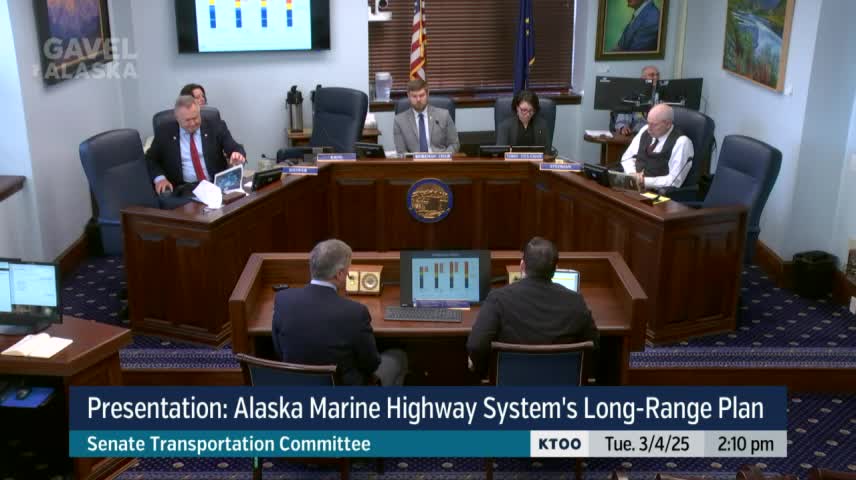Budget proposal includes $76M federal grant for rural ferry program in 2026
March 04, 2024 | 2025 Legislature Alaska, Alaska

This article was created by AI summarizing key points discussed. AI makes mistakes, so for full details and context, please refer to the video of the full meeting. Please report any errors so we can fix them. Report an error »

During a recent meeting of the Alaska Legislature's Transportation Committee, officials discussed the ongoing financial strategies surrounding the state's rural ferry program, which has been significantly influenced by federal funding opportunities. The meeting highlighted the proposed budget for the calendar year 2026, which includes a substantial $76 million federal grant anticipated from the Infrastructure Investment and Jobs Act. This funding is crucial as it aims to bolster ferry services for rural communities, a vital transportation link for many Alaskans.
The budget proposal also outlines an allocation of $20.7 million from state revenue and $61.4 million from unrestricted general funds. This financial framework reflects a strategic approach to enhance ferry operations while addressing the challenges posed by crew shortages that have limited the ability to fully utilize the budget in recent years.
Officials noted a concerning trend in ridership and revenue, which have not rebounded to pre-pandemic levels. In 2019, the ferry system generated $50.8 million from ridership, but this figure saw a significant decline during the COVID-19 pandemic, and recovery has been slow. The committee emphasized the importance of focusing on revenue generation as part of the long-range planning for the ferry system, indicating that addressing these financial challenges will be essential for sustaining operations.
The discussions also included a historical overview of the operating budget, revealing that the ferry system has not fully expended its budget in recent years due to crew limitations. This situation underscores the need for strategic workforce planning to ensure that the ferry services can meet the demands of Alaskan communities effectively.
As the committee moves forward, the emphasis on federal funding and the need for a robust recovery plan for ridership will be critical in shaping the future of Alaska's rural ferry services. The anticipated federal grant and the proposed budget reflect a proactive approach to addressing these challenges, but the path to recovery remains a key focus for state officials.
The budget proposal also outlines an allocation of $20.7 million from state revenue and $61.4 million from unrestricted general funds. This financial framework reflects a strategic approach to enhance ferry operations while addressing the challenges posed by crew shortages that have limited the ability to fully utilize the budget in recent years.
Officials noted a concerning trend in ridership and revenue, which have not rebounded to pre-pandemic levels. In 2019, the ferry system generated $50.8 million from ridership, but this figure saw a significant decline during the COVID-19 pandemic, and recovery has been slow. The committee emphasized the importance of focusing on revenue generation as part of the long-range planning for the ferry system, indicating that addressing these financial challenges will be essential for sustaining operations.
The discussions also included a historical overview of the operating budget, revealing that the ferry system has not fully expended its budget in recent years due to crew limitations. This situation underscores the need for strategic workforce planning to ensure that the ferry services can meet the demands of Alaskan communities effectively.
As the committee moves forward, the emphasis on federal funding and the need for a robust recovery plan for ridership will be critical in shaping the future of Alaska's rural ferry services. The anticipated federal grant and the proposed budget reflect a proactive approach to addressing these challenges, but the path to recovery remains a key focus for state officials.
View full meeting
This article is based on a recent meeting—watch the full video and explore the complete transcript for deeper insights into the discussion.
View full meeting
